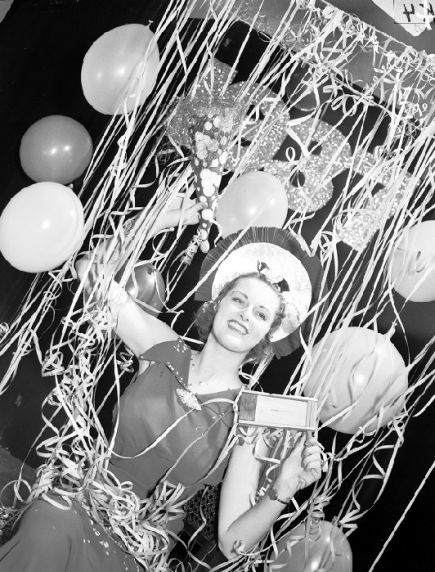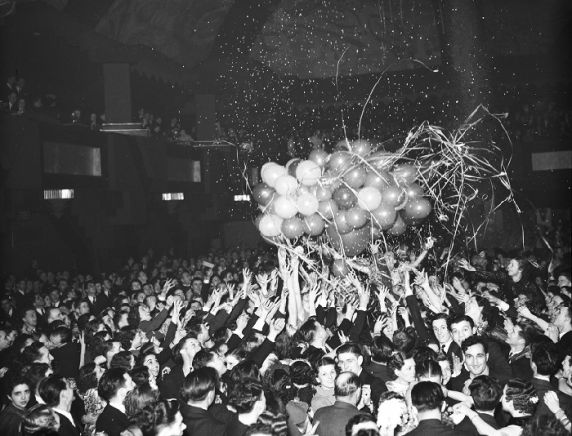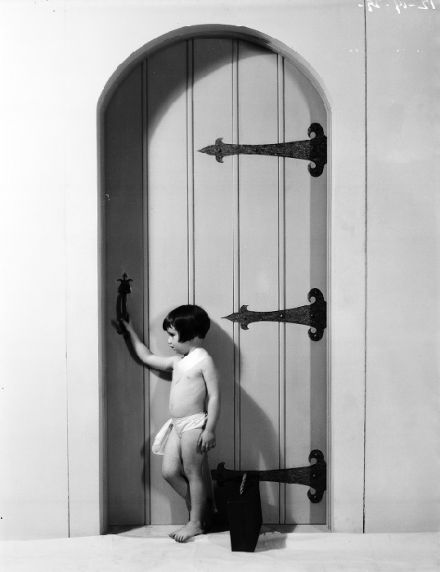Folklore Friday: New Year's Eve Edition
As 2017 draws to a close, it is time to look forward to all that is to come in the new year. This Folklore Friday we are sharing traditions and beliefs concerning New Year’s Eve. These customs are taken from student projects within the Folklore Archive that include interviews with immigrants or first-generation members of different ethnic communities throughout Southeastern Michigan, largely from Southern and Eastern Europe.
Detroit’s sizable Greek community is well represented in the Folklore Archives, and within the interviews, there are numerous mentions of New Year customs. In an interview with John V., used within his paper Greek Beliefs and Customs, Roger Conant recorded:
"On New Year’s Day, we have a special kind of bread that is baked for that day. Someplace in that bread there is a coin that is baked into the bread. The person who gets the piece of bread with the coin will have luck in the New Year."
In an interview from 1977, Mary Burkhardt noted that in Greece, on New Year’s Eve, it is customary to set an extra place at the dinner table for "Saint Bill or Saint Vassilios" in case he should stop by. St. Vassilis (or Bill) is also known as the Greek Santa Claus. Don Fairchild, Jr.’s paper Greek Holidays and Customs went further into this tradition in an interview with Nikolas A.:
"Now New Year’s Eve we used to give gifts because we believe Santa Claus bring the gifts that day but we not give so many gifts like here, just one gift to one another. We never give gifts to parents, just parents to children. There is another custom, an old custom, about New Year’s Eve. We think that day, the first person walks into your house, he will bring you luck to the whole family. Some people think if something happens to the whole family they blame that person."
It was also noted that on this day the father must enter the home first, or if he is not present, the children, to bring luck onto the household. The Greeks were not the only group to hold this belief. In her 1971 paper Hungarian Lore from Delay, Paula Ann Tofilski recorded that it was believed that on New Year’s Eve, "a man enters the door first to bring good luck."
In his 1959 paper A Collection of Folk Material of Ukraine, Daniel G. Taranowski collected several customs concerning New Year’s Eve from Irene and Walter T., both of whom immigrated from Ukraine to the United States nearly forty years prior:
"[It is] A very festive occasion where young and old join in much dancing, singing, and fortune telling. The fortune telling is done by boiling wax poured on cold water. The cooling wax on the water forms figures which are symbols of the future. The young girls, in the evening, go out to the back fences and count each stick of the fence saying: 'Widower...single man...widower...single man..' Whichever she stops her count on will be the type of man she will marry."
"Before sunrise, and very early in the morning children bring greetings for the New Year to all the neighbors. They recite verses and scatter grains of wheat or other seed over the floor as a symbol of good luck and generous prosperity for the coming year. The children are then treated with sweets or more likely pastries. They must, however, come very early, because by 9:00 New Year’s morning, the neighbors will refuse to admit them..by then they are knee-deep in wheat grain, anyway."
A more detailed look at New Year’s customs can be found within Birute Sileika’s 1965 paper Three Lithuanian Calendar Festivities. Within it she records:
"In the folk tradition, [New Year’s] was greeted with various amusements, merry-making, and fortune telling. In order to greet the New in the correct manner, the girls would dress as boys and the boys would impersonate the girls and they would go through the village frightening and teasing one another. Some would dress as animals, horses, and goats, and sometimes as skeletons with scythes on their shoulders. ...The popular belief among the folk was that on this night of New Year witches danced and that they could be seen before midnight hiding behind harrows. Besides these witches, the dead also arose on this eve to greet the New Year."
On New Year’s Eve everyone dabbled in a bit of superstition and witchcraft in foretelling their future. The most pertinent problems for the New Year were those of marriage and death. There were many methods of telling the future among the Lithuanian folk. Lead, wax, or egg whites were poured into water, a wrinkled paper was burned, and the people noted what form and figure came about in the water and the shape of the shadow of the burning paper was. Imagination was used here more than any real and actual figure although sometimes the weird did occur, and an actual shape of a person or thing was formed. Young maidens, wishing to know who and how and if they would marry, went out to the crossroads with rakes and there smoothed layers of snow. Early the next morning each one went out to see if anyone had passed by on that part of the snow. If the passerby had been barefooted, the maidens would wed a poor man; if the passerby had sandals, she would live in poverty, if the passerby had shoes, everything would be taken care of. If no one passed by, then she would remain unwed throughout the whole year and would have to try her luck again the following year. Other girls, wishing also to know if they would marry this year and to whom, would throw a ring in a glass of water. If the face of a man appeared in the center of the ring, he would be the one the girl would marry.
If one desired to know whether or not he would live through the year, he had to go outside when the moon was shining during the evening or the night and observe his shadow. If the shadow was without a head, then death would come this year.
"From the weather of the New Year predictions were made for the weather and living conditions of the entire year. If frost formed figures of wheat on the window panes then the wheat would be fruitful; if the figures resembled barley, then barley would be plentiful; and so on, similarly. If it snowed during the first day of the year then the cows would give much milk. If it was drifting, then the storeroom would be full through the whole year. A star-filled sky meant great fruitfulness among the animals. If the first sunrise was beautiful, then the year would be good and peaceful. If the sun was very red, then there would rage great wars the following year."
 In her 1976 paper Macedonian Folk Tradition from the Villages, Faye-Ann Scott interviewed Ted P., a 23-year-old auto worker, who reminisced about growing up in the village of Vratnica, Macedonia, which was then part of Yugoslavia:
In her 1976 paper Macedonian Folk Tradition from the Villages, Faye-Ann Scott interviewed Ted P., a 23-year-old auto worker, who reminisced about growing up in the village of Vratnica, Macedonia, which was then part of Yugoslavia:
"We don’t celebrate Christmas you know because of the ah, you know socialists you know. You can, but nobody cares about that. But we celebrate New Year's Eve. We stay out of work for four or five days. The government pays expenses. Celebrate New Year’s Eve, say young people, say, go to big places, restaurants, and bars. Celebrate all night. Drink a lot, I guess. Feel really happy."
Some traditions are universal, it seems. Wherever you are, the Reuther Library wishes you the happiest of
New Years!
Folklore Fridays is an exploration of a theme or topic found within the Folklore Archive through text, audio, or still imagery. It appears on the Reuther Library blog on a Friday of each month. The Folklore Archive, established in 1939, contains the oldest and largest record of urban folk traditions in the United States.
Elizabeth Clemens is an Audiovisual Archivist at the Walter P. Reuther Library.



 Reddit
Reddit Facebook
Facebook LinkedIn
LinkedIn